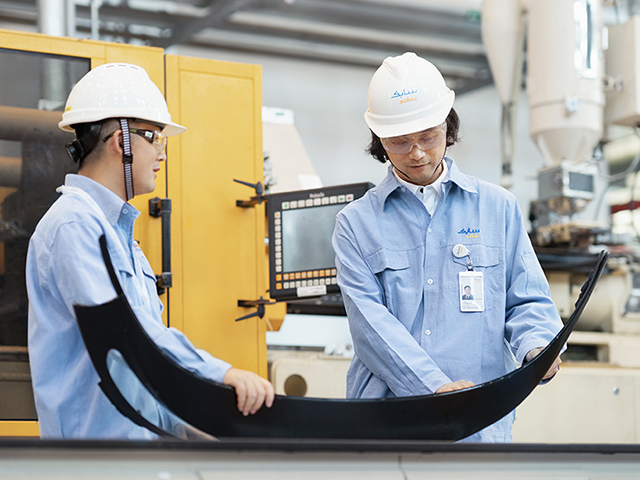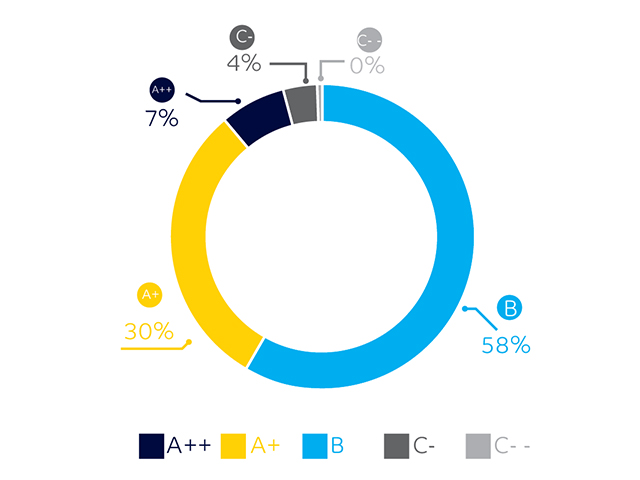OUR APPROACH AND PERFORMANCE
A sustainable future requires finding new solutions, new practices, and new ways of conducting business. Structural changes in the energy industry are putting pressure on SABIC’s carbon-intense oil and gas portfolio. In the consumer-goods industry, a growing number of buyers are placing importance on sustainability.
From innovative products made with recycled plastic, process improvements that reduce emissions, and collaboration with industry partners to minimize environmental impact across the value chain, SABIC is committed to responding to these challenges and discovering avenues that benefit our business, our customers, and society.
As a materials company positioned between the energy industry and the consumer-goods industry, innovation is the linchpin that connects our ambitious growth agenda with our sustainability goals. Through our capabilities and investments in innovation, SABIC continues to make progress in its circular economy efforts and in building a future that allows us to protect the planet for the decades ahead.
Our approach to innovation and sustainability solutions is framed around three focused chemical-sector strategic priorities that support our vision of being the preferred world leader in chemicals. Using feedstock optimization as a key lever to increase flexibility and competitiveness in our petrochemicals and agri-nutrients business, we are prioritizing segment-driven innovation, which opens up growth opportunities through new markets and applications, and process innovation, which allows us to improve reliability, capabilities, and cost efficiencies in manufacturing. In our Specialties business, technology is the lever that allows us to create a competitive edge and differentiation by customizing solutions for pioneering OEMs.
We view external collaborations as essential to accelerating technology delivery and advancing disruptive innovation. Our collaborators include international universities and institutes (such as the Massachusetts Institute of Technology (MIT), Peking University, and the University of Toronto); technology ventures (such as Finboot Tech, Pangaea Ventures Limited, and BiOWiSH Technologies), and Saudi Arabian universities and institutes (such as King Saudi University, King Abdulaziz City for Science and Technology (KACST), and Qassim University). By building a robust external innovation eco-system, SABIC is in a strong position to acquire new and unique competencies; support projects and expand capabilities; scout for new opportunities; extend capacity and reduce Trailing 12 months (TTM) and cost; build talent to create a pipeline of groundbreaking ideas; and, additionally, make a broader impact in our partnerships with Saudi Arabian universities by helping develop their capabilities through knowledge sharing and collaborations.
ENABLING AND IMPACTING TRANSFORMATIONAL ECONOMIES
New innovations and technologies, along with greater impetus toward decreasing GHG emissions and moving toward a circular economy, are creating advanced market niches that have the potential to benefit society and open avenues for economic growth. SABIC has been working to enable these transformational economies, and made a significant impact in key areas in 2022.
The Exabyte Economy promises to create an ecosystem of hyperconnected devices, data, and people that is estimated to be worth US$ 8 trillion. Our R&D100 award-winning LNP™ THERMOCOMP™ OFC08V compound is a material well suited for 5G base station dipole antennas and other electrical applications to speed up 5G networking access and to enable an industry leading all-plastic antenna design.
Meanwhile, our progress to tap into the US$ 4.5 trillion Circular Economy* is already underway. SABIC is constructing its first demonstration advanced recycling unit, that holds an initial capacity to convert 15-20 kt per annum of raw pyrolysis oil into certified circular polymers.
The Wellbeing Economy is poised to redefine health – particularly in a post-COVID-19 world – with a total expected value of over US$ 7 trillion by 2025*. SABIC is leveraging its technology and resources to provide a broad portfolio of healthcare materials that span our product line from polyolefins to high performance plastics including ULTEM™ (PEI) resin, LNP™ ELCRES™ copolymer resin, LEXAN™ (PC) resin, SABIC® PP resin, and other specialty compounds. At our Technology and Innovation (T&I) facilities, we are also working on new technologies and advanced materials to address the major challenges faced by the healthcare industry. By enabling the provision of surgical, pharmaceutical, patient testing, fluid & blood handling, respiratory & sleep therapy, and medical facility infrastructure solutions, SABIC aims to help contribute to a healthier future.
The Net Zero Economy, worth US$ 2.3 trillion*, includes our efforts to reduce carbon emissions, such as the construction of the world’s first demonstration plant for an electrically-heated steam cracker furnace; and developing products for EVs to help the automotive industry transition faster to a cleaner, electrical world.

SABIC is focusing on new innovations and technologies that are creating advanced market niches.
The increase in the world’s population requires expanding food production and constructing larger robust infrastructure that provides access to energy to more people in a sustainable manner. SABIC has tapped into the US$ 1 trillion-worth Bio-growth Economy 1 by deploying our Edison Award-winning technology to enhance agri-nutrients to grow food crops that have up to 10% higher yield with lower CO2 emissions. Simultaneously, we are using our patented Blue Urea innovation produced via third-party certified (TÜV-R) Blue Ammonia with zero Carbon Footprint and Next Generation Fertilizer. To help with building sustainable infrastructure, our enhanced pipe technology has a 30% thickness reduction while guaranteeing longer durability, ensuring system structures that will last many lifetimes without needing to be replaced.
Our efforts to push for a more circular and sustainable future were recognized at the Edison Awards in 2022, where we won five Edison Awards across four different categories. Moreover, SABIC showcased its TRUCIRCLE™ program for manufacturers along with our new program, BLUEHERO™, at K-Show 2022. At the show, SABIC also exhibited a broad range of differentiated material solutions and applications samples targeting improved functionality, sustainability, safety, design, cost, and patient and consumer convenience that meet the needs of the hygiene and healthcare industry.
Performance metrics
-
Total active patent portfolio
9,948 /
233(PATENTS AND PENDING APPLICATIONS)/NEW PRIORITY-PATENT APPLICATIONS IN 2022
-
New priority patent applications in 2022
~55%
ASSOCIATED WITH PSA-ASSESSED RESEARCH PROJECTS AS HAVING A SUSTAINABILITY CLASSIFICATION
-
SUSTAINABILITY-DRIVEN SOLUTIONS
>50%
-
IMPROVEMENT IN % OF INNOVATION
EBITDA/BUSINESS EBITDA (2019-2022 YTD)
15+%
-
ACTIVE R&D PROJECTS
450+
-
R&D CENTERS WORLDWIDE
18
-
R&D EMPLOYEES
2,000+
Strategic Intellectual Property protection is one of the cornerstones of SABIC’s technologydevelopment efforts. By the end of 2022, SABIC’s active patent portfolio stood at 9,943 granted patents and pending applications, including 233 new priority-patent applications filed during the year. Innovation around sustainable technologies, such as carbon neutrality, circularity, process improvements, operational efficiencies, light-weight solutions, chemical safety and sustainable applications, continues to be a key driver for SABIC research efforts and is systematically monitored by the organization. 20% of SABIC’s active patent portfolio relates to sustainability as per the Portfolio Sustainability Assessment (PSA) methodology; similarly, ~55% of new priority patent applications filed in 2022 relate to sustainability.
SABIC’S PORTFOLIO SUSTAINABILITY ASSESSMENT (PSA) APPROACH
The PSA approach, sponsored by the World Business Council for Sustainable Development (WBCSD), is a robust methodology and framework of sustainability criteria to analyze companies’ product portfolios. SABIC, along with several other industrial peers in the chemical sector, has participated in the design and development of this methodology since its inception.
By providing an assessment of the sustainability of applications and products, the PSA enables better decision-making and more impactful, market-driven sustainability and innovation strategies. This, in turn, allows SABIC to maintain a strong presence in the market, where new demands and needs – and more stringent environmental regulations – are emerging, and meet our customers’ and other stakeholders’ expectations and ambitions for sustainable solutions.
After gaining experience from running two pilot assessments with some polymers segments in 2018 and 2020 (the details of which were published in our previous Sustainability Reports), SABIC applied the full scale of the PSA methodology to a broad part of its business for the first time in 2022, covering 48% of revenues at corporate level and assessing 412 grades in 149 products/applications.
Products with strong sustainability-related benefits were categorized as A++ (advanced) and A+ (progressing) and comprised 37% of the screened revenues. Such products contribute to reducing customers’ carbon footprint or conserving resources at the application level, and help customers develop their own sustainable applications. To date, some key A++ and A+ products in our portfolio include foam insulation products, lightweight polymer solutions, and low carbon steel products.
In addition, the PSA identified some flagged (C-) and challenged (C- -) products/applications. These products are related to 1) additives that are substances of concern, which we are addressing through our product stewardship program, “Safer Chemistry” and 2) applications with risk derived from end user responsibility, which we are addressing through our TRUCIRCLETM program.
PSA PERFORMANCE CATEGORIES % REVENUE, 2022

|
|
||
|---|---|---|
| Advanced | A++ | |
| Progressing | A+ | |
| Compliant | B | |
| Flagged | C- | |
| Challenged | C-- |
By the end of 2023, we aim to expand our PSA coverage and enhance the granularity of our PSA specifically in relation to risk assessment. After establishing a robust baseline of SABIC’s portfolio by the end of 2023, the intention is to perform a PSA update every four years.
In addition to our commercial portfolio, the PSA methodology was also adopted across the entire T&I portfolio in 2022 to assess the sustainability performance of all research and development projects. In 2014, we implemented an in-house second generation sustainability assessment methodology for all T&I projects with the intent of tracking the sustainability attributes of projects at the portfolio level. This assessment was guided by lifecycle assessment (LCA) principles and used to evaluate T&I projects against three sustainability metrics: environment, economics and social. While this methodology has been effectively utilized for internal tracking and decision-making over the past years, the recent developments in PSA guidelines presented a great opportunity to upgrade and standardize our sustainability assessment in line with external, global standards and practices to ensure transparency and consistency.
As part of the rollout of the new PSA-based sustainability assessment framework across the T&I portfolio, we also upgraded our portfolio analytics to be able to track the contributions of projects under 20+ solution directions such as circularity, decarbonization, etc. This classification enables us to assess the distribution of projects under key sustainability focus areas, leading to informed decision-making on the portfolio over near and long-term. Assessment scores based on the PSA framework are also being validated using LCA studies. Additionally, further analysis on sustainability patents as a proportion of overall patents has been introduced as a new metric in our sustainability reporting for 2022 (see ‘Performance Metrics’ above).
In the coming years, the PSA will be a crucial tool in enabling SABIC to accelerate growth in sustainable sectors and increase our abilities to help challenged sectors become more sustainable. The PSA will identify and document the sustainability contribution of new technological developments, such as our TRUCIRCLE™ product line, as well as changes in process like the use of renewable electricity, helping us steer our portfolio toward more sustainable solutions. Moreover, our intention is to have the PSA become a regular disclosure in our Sustainability Report, offering a standardized, credible communication on our approach to sustainability to our investors and stakeholders.
